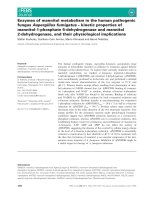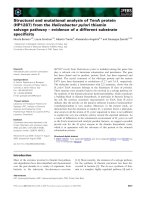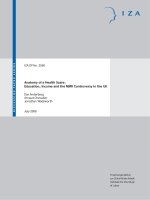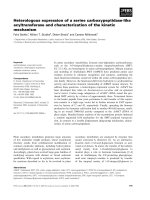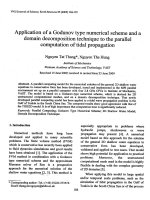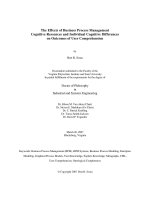Appropriate methods in determining the event mean conce pollutant removal efficiency of a best management practice ntration and
Bạn đang xem bản rút gọn của tài liệu. Xem và tải ngay bản đầy đủ của tài liệu tại đây (1.89 MB, 9 trang )
DOI:10.4491/eer.2010.15.4.215
pISSN 1225-1025 eISSN 2005-968X
Environ. Eng. Res. 2010 December,15(4) : 215-223
Research Paper
215
©
Copyright The Korean Society of Environmental Engineers
Appropriate Methods in Determining the Event Mean
Concentration and Pollutant Removal Efficiency of a
Best Management Practice
Marla C. Maniquiz
1
, Jiyeon Choi
1
, Soyoung Lee
1
, Hye Jin Cho
2
, Lee-Hyung Kim
1†
1
Department of Civil and Environmental Engineering, Disaster Prevention Research Center, Kongju National University, 275 Budaedong,
Seobukgu, Cheonan 331-717, Korea
2
Highway Research Division, Infrastructure Research Department, Korea Institute of Construction Technology, Koyang 411-712, Korea
Abstract
This study attempted to develop and suggest a more appropriate method for the determination of event mean concentration (EMC)
and pollutant removal efficiency of a stormwater best management practice (BMP) considering rainfall. The stormwater runoff and
hydrologic data gathered from 22 storm events during a 28-month monitoring period on a swirl and filtration type of BMP were used to
evaluate the developed methods. Based on the findings, the modified EMC method resulted in lower (average) values than the overall
EMC, although the differences were not significant (P>0.05). By comparison, the developed ‘Rainfall Occurrence Ratio’ (ROR) method
was most significantly correlated (r=0.967 to 988, P<0.009) with the other existing removal efficiency determination methods such as
the ‘Efficiency Ratio’ (ER), ‘Summation of Loads’ (SOL) and ‘Regression of Loads’ (ROL) methods. In addition, the ROR method gave the
highest efficiency values, with no significant differences with any of the pollutant parameters, unlike the other three methods. These
results were obtained because the ROR method integrated both pollutant loading and rainfall, which are not considered by the other
three methods. Therefore, this study proved the suitability of the modified EMC and ROR methods for application in other BMP moni-
toring studies.
Keywords: Best management practice, Event mean concentration, Efficiency, Filtration, Rainfall occurrence ratio method, Stormwater
sequently, the MOE introduced the total maximum daily load
(TMDL) approach in 2004. The TMDL regulates or controls the
pollution load discharged below the total amount allowed to at-
tain the water quality target of streams [6]. The MOE is aggres-
sively pursuing the implementation and compliance with the
TMDL for watershed protection, and effective control of NPS
is believed to be the key method for successfully meeting the
TMDL [7, 8]. Changes in management policies have resulted
in the introduction of pilot projects, termed ‘best management
practices’ (BMP), adopted from the United States. The objectives
of the program are to determine catchment areas, determine
runoff characteristics and evaluate the treatment performance
of structural BMPs, as many introduced in Korea have only been
based from literature studies that do not reflect the climatic
characteristics and geographical features of the country. The re-
sults of BMP case studies will be used to facilitate the design of
similar BMP types and optimize NPS management policies (e.g.,
TMDL) in Korea.
Based on the National Pollutant Removal Performance Da-
tabase for Stormwater Treatment Practices of the United States
1. Introduction
The constant expansion of water related infrastructure such
as sewage treatment plants by the Korean Government has con-
tributed to a notable reduction of point source pollution. Yet,
nonpoint source (NPS) pollution is increasingly affecting water
quality [1]. In 2003, the contribution of NPS loadings to major
rivers accounted for almost half the total loading, and is pre-
dicted to rise to 70% by 2015 if no adequate control measures
are introduced [2]. Sprawl, which is the irresponsible develop-
ment, is the major contributor to the increase in NPS loadings
and volume of stormwater runoff. Bannerman et al [3] found
that streets with impervious surfaces contained the highest pol-
lutant loads in most land use categories. Impervious covers can
double, triple, quadruple or even quintuple peak discharge [4].
Urban stormwater managers seek technologies that are able to
address the flow and water quality impacts of urbanization [5].
The pollutant concentration-restricting approach by the
Ministry of Environment (MOE) has not been very effective at
improving the water quality of the major rivers in Korea. Con-
Received
October 01, 2010
Accepted
November 22, 2010
†
Corresponding Author
E-mail:
Tel: +82-41-521-9312 Fax: +82-41-568-0287
This is an Open Access article distributed under the terms of the Creative
Commons Attribution Non-Commercial License (http://creativecommons.
org/licenses/by-nc/3.0/) which permits unrestricted non-commercial use,
distribution, and reproduction in any medium, provided the original work is
properly cited.
Marla C. Maniquiz, Jiyeon Choi, Soyoung Lee, Hye Jin Cho, Lee-Hyung Kim
216
DOI:10.4491/eer.2010.15.4.215
water runoff and was responsible for the removal of sediments,
free-floating oil and debris by the mechanism of sedimentation,
the runoff then flowed directly to the internal spillways across
the second device, which was a filtration chamber that allowed
runoff to permeate through the pores of perlite filter cartridges
via filtration. Subsequently, the treated runoff was channeled
through an outlet pipe and discharged to the adjacent stream.
2.1.2. Storm Event Sampling
A total of 22 storm events were sampled during the monitor-
ing period from 06/2006 to 10/2008 to evaluate the pollutant
removal efficiency of the swirl and filtration system in the treat-
ment of stormwater runoff. Continuous flow measurements
were performed and rainfall data collected to obtain a relatively
unbiased approximation of the pollutant mass loads. The total
sampling time was adjusted to approximate the time during
which the “first flush” was processed [10]. Generally, at least 12
samples were manually collected at both the inlet and outlet.
Typical water quality parameters were measured, including TSS,
biochemical oxygen demand (BOD), chemical oxygen demand
(COD), dissolved organic carbon (DOC), TN, TP, heavy metals
(zinc, lead, etc.), and oil & grease (O&G). Analyses of these pa-
rameters were performed in accordance with standard methods
[11].
2.2. Calculations and Data Analyses
2.2.1. Event Mean Concentration
The EMC is an important factor in predicting the total pol-
lutant load, which has made the EMC a critical parameter for
estimating the contribution of runoff to receiving waters [12,
13]. The EMC was used to quantify the average pollutant load
washed off during a storm event with respect to the event runoff
volume. The pollutant loading for a storm event is calculated by
the summation of loadings during each sampling period using
Environmental Protection Agency (U.S. EPA), the median per-
formances of filtering practices for total suspended solids (TSS),
total nitrogen (TN) and total phosphorus (TP) were 86, 32 and
50%, respectively [9]. It has to be emphasized that the median
removal efficiency was used instead of the mean that resulted in
higher values. The issue of reporting pollutant removal efficien-
cies needs to be addressed, particularly for each type of BMP,
because if a wide range of removal efficiencies exists, employ-
ing an appropriate stormwater treatment strategy will be diffi-
cult. Therefore, this study aimed to develop a more appropriate
method for the characterization of stormwater runoff using the
event mean concentration (EMC) and calculate the pollutant
removal efficiency of a stormwater runoff treatment system for
BMPs. Although existing methods are available and currently
practiced in most BMP studies, the uncertainties in reporting
overall average EMC and removal efficiency values should be
eliminated, or at least reduced. The data used in this study was
obtained from a 28-month monitoring during 22 storm events
on a swirl and filtration system, a type of BMP for the treatment
of stormwater runoff.
2. Materials and Methods
2.1. Site Description and Monitoring Scheme
2.1.1. Site Location and Facility Description
A swirl and filtration system (surface area=19.2 m
2
) was in-
stalled in an asphalt-paved parking lot (100% impervious),
which drained a 10,700 m
2
catchment area. The main function of
the facility was to remove sediments, suspended solids, particu-
late pollutants, petroleum hydrocarbons, heavy metals and nu-
trients from stormwater runoff by means of sedimentation and
filtration mechanisms. Fig 1 shows a detailed description of the
system. The facility was comprised of two devices in sequence;
first, a swirl tank, which provided pre-treatment of the storm-
Fig. 1.
Schematic of the swirl and filtration system.
Appropriate Methods in Determining the Event Mean Concentration and Pollutant Removal Efficiency of a Best Management Practice
217
Second, the “summation of loads (SOL) method” [14], which is
based on the ratio of the summation of the total incoming loads
to that of the total outgoing loads (Eq. 4).
∑
∑∑
−
=
loading Inlet
loading Outletloading Inlet
(%) Removal
(4)
Third, the “regression of loads (ROL) method” [16], where the
regression efficiency is defined in terms of the slope (β) of a least
squares linear regression of the inlet and outlet pollutant loads,
with the intercept constrained to zero (Eq. 5).
11
loading Inlet
loading Outlet
(%) Removal −=−=
β
(5)
Finally, another method, termed the “rainfall occurrence ratio
(ROR) method” was proposed and used in this study to evaluate
the efficiency. The ROR method was developed to consider the
variability of the rainfall characteristics at the monitoring site
that might affect the average removal efficiency. The removal ef-
ficiency can be calculated by multiplying the average removal
efficiency obtained from the ER method by the rainfall occur-
rence ratio, n
i
/n
t
(Eq. 6). The rainfall occurrence ratio in Table
1 equals the number of rainy days for a specific rainfall range
divided by the total number of rainy days during the entire mon-
itoring period.
)(
∑
×= ratio occurence Rainfall(ER) efficiency Removal(%) Removal
(6)
All statistical hypotheses were tested at the 5% level (α = 0.05)
using a one-way analysis of variance (ANOVA). The SYSTAT 12
software package (© SYSTAT Software Inc., Richmond, CA, USA,
2007) and OriginPro 7.5 SRO v7.5714 (B714) (© OriginLab Cor-
poration, Wellesley, MA, USA, 1991-2003) were used for the sta-
tistical analyses and plotting of data.
3. Results and Discussion
3.1. Hydrologic Data
3.1.1. Rainfall
The rainfall during the monitoring period between 06/2006
and 10/2008 is shown in Fig. 2. A steep accumulated rainfall curve
in Fig. 2(a) was apparent during the summer seasons, from June
to August, when most of the rainfall occurred. In Korea, a typical
rainfall event averages 14 mm. However, the median rainfall is 5
mm lower than the mean which suggests most rainfall events in
Korea are small. In fact, almost 68% of the rainfall that occurred
the volume (or flow rate) for that period. The equation below is
used for the determination of the EMC:
eventper volumerunoff total
eventper loadingpollutant total
1
V
n
i
ii
CV
EMC
∑
=
==
(1)
where EMC = event mean concentration, mg/L; V = total runoff
volume per event, L; V
i
= runoff volume proportional to the flow
rate at time i, L; C
i
= pollutant concentration at time i, mg/L; and
n = total number of samples during a single storm event
Based on the above equation, the EMC calculated for each storm
event only represents the concentration with respect to the flow
or volume which might lead to overestimated or underestimat-
ed values when arithmetically averaged for the total number of
storm events. For instance, a storm with little rainfall will result
in a high EMC value, while that with large rainfall will yield a
small EMC value because the EMC is averaged over the entire
storm event. Therefore, a more specific approximation of the
average EMC over the entire monitoring period was developed
using the rainfall ratio, α
i
/α
t
(see Table 1). The equation for the
calculation of the modified EMC in this study is shown below:
1
t
10mm 10 20mm
i
m 10mm 10 20mm i
i
t
t t
EMC EMC EMC EMC
α α
α
α
α α
−
−
=
= + +
∑
(2)
where EMC
m
= modified average EMC, mg/L; EMC
i
= calculated
average EMC based on the rainfall range i, mg/L; α
i
= total rain-
fall depth within the rainfall range i, mm; α
t
= total rainfall depth,
mm; and t = total number of rainfall ranges
The rainfall ranges can be selected based on the rainfall char-
acteristics. In this study, three ranges were chosen, as follows:
less than 10 mm, 10 to 20 mm and greater than 20 mm of rainfall.
The EMC for each pollutant was calculated for each event and
then categorized for each of the rainfall ranges. Finally, the over-
all EMC was computed and compared with that of the modified
EMC.
2.2.2. Removal Efficiency
Various efficiency methods are used by investigators in BMP
monitoring studies to evaluate pollutant removal efficiencies
[14]. In this study, four methods were selected and applied to
assess the efficiency of the swirl and filtration system. First, the
“efficiency ratio (ER) method” [15], which is defined in terms of
the average removal efficiency of pollutants for each storm event
(Eq. 3).
EMC inlet Average
EMC outlet AverageEMC inlet Average
(%) Removal
−
=
(3)
Table 1. Total rainfall and number of occurrences (06/2006 to 10/2008)
Rainfall range
Total number of rainy days
(n)
Occurrence ratio
a)
(n
i
/n
t
)
Total rainfall
(mm)
Rainfall ratio
b)
(
α
i
/α
t
)
<10 mm 149 0.642 446 0.124
10 to 20 mm 28 0.121 386.9 0.107
>20 mm 55 0.237 2
,
772.3 0.769
Cumulative 232 1 3
,
605.2 1
a)
Ratio of rainfall occurrences (for each range) to total rainfall occurrences
.
b)
Ratio of rainfall (for each range) to total rainfall
.
Marla C. Maniquiz, Jiyeon Choi, Soyoung Lee, Hye Jin Cho, Lee-Hyung Kim
218
DOI:10.4491/eer.2010.15.4.215
rea during the study period. Due to the high rainfall intensity of
15.2 mm/hr during the 08/26/2006 storm (data not shown), the
runoff exceeded the storage capacity of the facility and resulted
in extreme overflow.
3.2. Runoff Water Quality
3.2.1. Pollutant Pattern
The plots in Fig. 3 illustrate the typical patterns of pollutant
concentrations at the inlet and outlet of the swirl and filtration
system with respect to flow and time. Apparently, the existence
of the first flush was clearly identified for the TSS and metal con-
centrations during a relatively short period at the very beginning
of the storm only at the inlet. Metals are known to often move
from paved surfaces used for transportation by being adsorbed
onto particulate materials [17]. The outlet concentration did not
exhibit a first flush effect, signifying the efficiency of treatment
via the swirl and filtration system. Nonetheless, the outlet con-
centration only appeared to be slightly reduced, and remained
almost constant during the entire storm event, signifying the
limitation of the swirl and filtration system in the treatment of
stormwater runoff from paved areas.
was below 10 mm, with 76% below 20 mm Fig. 2(b). The sum of
the maximum rainfall for each year over a three year period was
about one-third of the total rainfall over three years.
Table 1 provides the rainfall data used in the calculation of
the modified EMC (Eq. 2) and efficiency using the ROL method
(Eq. 6). Accordingly, the rainfall ratio and occurrence ratio were
very different for the <10 mm and >20 mm rainfall ranges. It has
to be emphasized that even though the majority of storms oc-
curred with rainfall <10 mm, the total rainfall was still small. On
the other hand, almost similar ratios were observed for the 10
to 20 mm rainfall range, indicating that this range was least af-
fected by the modified EMC calculations.
3.1.2. Storm Event
The summary of the monitored event data are provided in
Table 2, which includes antecedent dry day (ADD), total rain-
fall, runoff duration and the sampling frequency ratio. The me-
dian rainfall was 10.5 mm, suggesting that most of the sampled
storm events were less than 10 mm (50% of the total sampled
events). However, the sampling ratios of each rainfall range were
highly correlated (r=0.99, P<0.0001) with the occurrence ratio of
rainfall, as shown in Table 1, which means that the conducted
sampling trips were representative of the overall rainfall in Ko-
Fig. 2.
Rainfall during the monitoring period (06/2006 to 10/2008).
0
500
1000
1500
2000
2500
3000
3500
4000
0
25
50
75
100
125
150
175
200
Cumulative rainfall, mm
Daily rainfall, mm
Date (yy/mm)
06/04
06/06
06/08
06/10
06/12
07/02
07/04
07/06
07/08
07/10
07/12
08/02
08/04
08/06
08/08
08/10
(a) Daily and accumulated rainfall (06/2006 to 10/2008)
0
20
40
60
80
100
0 10 20 30 40 50 60 70 80 90 100
Occurrence Frequency (%)
Daily Rainfall (mm)
68%
76%
(b) Annual rainfall frequency curve (2007)
0 100 200 300 400
0
300
600
900
1200
0
40
80
120
0
20
40
60
80
100
120
140
0
2
4
6
8
10
Tss (mg/L)
Time (min)
Turbidity (NTU)
Oil & Grease (mg/L)
Flow (m
3
/hr)
Flow
Tss In
Tss Out
Turbidity In
Turbidity Out
O&G In
O&G Out
(a) TSS, Turbidity, Oil & Grease
Time (min)
Flow (m
3
/hr)
Flow
Cd In
Cd Out
Pb In
Pb Out
Zn In
Zn Out
0 100 200 300 400
0
300
600
900
1200
0
40
80
120
160
200
0
2000
4000
6000
8000
0
500
1000
1500
Cd (ug/L)
Pb (ug/L)
Zn (ug/L)
(b) Cd, Pb, Zn
Fig. 3. Multiple hydro-and polluto graphs for the 07/09/2007 storm event.
Appropriate Methods in Determining the Event Mean Concentration and Pollutant Removal Efficiency of a Best Management Practice
219
3.3. Pollutant Removal Efficiency
The treatment capability of the swirl and filtration system
was evaluated based on the total monitored storm events using
four efficiency determination methods, including the ER, SOL,
ROL and ROR methods. The efficiencies were also determined
for each corresponding rainfall ranges. Linear correlations be-
tween the methods were displayed in the scatter plot matrix
(SPLOM) in Fig. 6 and probability matrix in Table 3. As revealed
by the linear regression lines in SPLOM, the overall average ef-
ficiencies of the four methods were all positively correlated, with
the exception of the >20 mm range. This result suggests that the
efficiency of the system was highly variable when the storm
event has greater than 20 mm of rainfall. Moreover, it also proves
that the system is more efficient for storm events having less
than 20 mm, and even better 10 mm of rainfall. The design of a
facility for the treatment of stormwater runoff usually employs
rainfall during which the first flush occurs because treating all,
or a larger volume of runoff is impractical and uneconomical.
Therefore, achieving high treatment efficiencies is still difficult
(e.g. 90 to 100% pollutant removal).
Comparing the four methods, the ROR method appeared to
be the most highly and significantly correlated with the other
three methods, with a minimum Pearson correlation coefficient
(r) of r = 0.967 (P=0.002). The SOL method was next, and also
significantly correlated with the other three methods, with a
minimum r value of 0.926 (P=0.0027). On the other hand, the ER
and ROL methods were not significantly correlated (P=0.343).
Although the other methods are always useful to assess the over-
all average efficiency of the treatment system, the ROR method
gave the highest confidence in reporting the overall efficiency
of the treatment system. The ROR method; therefore, would be
suitable for application to other BMP monitoring studies.
The overall average removal efficiency of the swirl and filtra-
tion system calculated using the four methods is shown in Fig.
7. The highest removal efficiency was achieved for oil and grease
(O&G) with greater than 70% removal. The other pollutant pa-
rameters merely attained less than 50% removal efficiencies.
The ROF method showed the highest efficiency compared to
the other three methods, with the exceptions of TSS and DOC;
however, the differences were not significant. The ER method,
which considers only the EMC in the calculation of the removal
efficiency, yielded significantly lower efficiency value for TSS
(P=0.009). In addition, the SOL and ROL methods also signifi-
cantly affected the O&G removal efficiency (SOL, P=0.03; ROL,
P=0.029). In summary, the computed removal efficiencies var-
ied because only the EMC or mass loads of pollutant were con-
sidered. Therefore, the ROR method provided an unbiased ap-
3.2.2. Event Mean Concentration
The average pollutant concentrations of typical water quality
parameters in urban runoff studies are generally quantified by
means of the EMC. Given that stormwater runoff s associated
with high uncertainties due to site and rainfall characteristics,
the EMC values can also be affected, as reflected by the wide dis-
tribution and deviation of the EMC values found in several stud-
ies in Korea [6, 17, 18]. For example, the pollutant EMC values
based on 12 stormwater runoff studies by Kim et al. [17], con-
ducted at parking lots, resulted in average EMC values of 115,
35, 4 and 1 mg/L for TSS, BOD, TN and TP, respectively. These
results were higher compared to those found in this study. Cli-
mate, weather and geography tend to affect average EMC values.
It is possible that a very accurate (statistical) analysis should be
performed to eliminate the uncertainties in predicting EMC val-
ues. Fig. 4 shows the comparison of the calculated EMC values
for various pollutants with respect to the three rainfall ranges
(i.e., <10 mm, 10 to 20 mm and >20 mm rainfall), both cumu-
latively (i.e. using arithmetic average of the total events) and
modified (calculated by using Eq. 2). All measured parameters
exhibited significant differences between the inlet and outlet
EMC values (P<0.01) for the three rainfall ranges, with the ex-
ceptions of the TSS (P=0.037) and turbidity (P=0.11). Based on
the graphs, an apparent trend was observed in the relationship
between the EMC and rainfall depth; the greater the rainfall,
the smaller the EMC, and vice versa. Likewise, increases in the
rainfall and rainfall intensity corresponded with the decrease
average EMC values. Due to long duration and heavy rainfall,
the average EMC value will be small. Therefore, it is safe to as-
sume that rainfall is one of the factors affecting the differences
in the EMC values, as well as the loading and flow or volume of
runoff. Concurrently, rainfall can be included in the calculation
of representative (overall) EMC values. Customarily, the overall
EMC value is reported by arithmetically averaging the individual
EMC for each storm event over the entire monitoring period. A
modified EMC value was introduced in this study to account for
the distribution of rainfall (termed the ‘rainfall ratio’ in Table 1).
This idea opposes the previous discussion (as depicted in Fig.
4), which showed an inverse relationship between the EMC and
rainfall depth. Therefore, it follows that the EMC is dependent
on the rainfall ratio. Comparing the overall and modified EMC
values for various pollutant parameters (Fig. 4), the modified
EMC values were smaller by 13±12% (mean±standard deviation)
than the overall EMC values. Nevertheless, the modified EMC
was highly correlated with the overall EMC, as verified by the
linear fit in Fig. 5.
Table 2. Summary of the monitored event data (n=22)
Parameter Min/Max Median Mean±SD Sampling frequency ratio
a)
ADD (day) 1/33 5 7.3
±
7.3 NA
Total rainfall (mm)
<10 mm
1.5/55.5 10.5 17.9
±
18.1
0.5
10 to 20 mm 0.2
>20 mm 0.3
Runoff duration (hr) 1/14 6.5 6.6
±
4.2 NA
ADD: antecedent dry day, NA: not applicable.
a)
Ratio of sampling trips (for each range) to total sampling trips
.
Marla C. Maniquiz, Jiyeon Choi, Soyoung Lee, Hye Jin Cho, Lee-Hyung Kim
220
DOI:10.4491/eer.2010.15.4.215
Fig. 4. Inlet and outlet pollutant event mean concentrations (EMC) ± standard error for each rainfall range and the cumulative EMC during the
monitoring period (06/2006 to 10/2008). The modified EMC value at the inlet is denoted by the black dashed line.
Appropriate Methods in Determining the Event Mean Concentration and Pollutant Removal Efficiency of a Best Management Practice
221
50
40
30
20
10
0
0 10 20 30 40 50 60 70
Overall EMC
Modif ied EMC
R
2
= 0.987
p = 0.00478
Fig. 5. Linear fit and correlation between the modified event mean
concentration (EMC) and overall EMC at the inlet.
Fig. 7. Overall average removal efficiency of the swirl and filtration
system using the four efficiency determination methods (ER, SOL,
ROL and ROR) during the monitoring period (06/2006 to 10/2008).
ER10ER1020ER20ERSOL10SOL1020SOL20SOLROL10ROL1020ROL20ROL
ER10
ROR
ER1020 ER20 ER SOL10 SOL1020 SOL20 SOL ROL10 ROL1020 ROL20 ROL ROR
Fig. 6. Scatter plot matrix (SPLOM) of various efficiency determination methods showing the regression line with 95% upper and lower confi-
dence intervals using a linear smoother method; and the density in diagonal cells, as displayed by the histogram.
Marla C. Maniquiz, Jiyeon Choi, Soyoung Lee, Hye Jin Cho, Lee-Hyung Kim
222
DOI:10.4491/eer.2010.15.4.215
proximation of the average removal efficiency since it takes into
account both the EMC and rainfall frequency. Indeed, the rain-
fall characteristics govern the factors affecting the removal ef-
ficiency. For instance, for the August 26, 2006 storm event (data
not shown), where the rainfall intensity was highest at 15 mm/hr
(48.5 mm rainfall), overflow occurred in the sedimentation tank,
which resulted in a low removal efficiency value.
4. Conclusions
The swirl and filtration system evaluated in this study is one
of the many types of BMP previously and currently employed
for managing stormwater runoff in Korea. However, due to vari-
able site and climatic characteristics, it is not easy to suggest a
general management strategy for the control of (NPS) pollutants
in stormwater runoff. For this reason, investigations on the ef-
ficiency of treatment facilities are required. While long term
monitoring of storm events is best for eliminating the uncer-
tainties and accurately predicting the efficiency of systems, this
is laborious and costly. Thus, the appropriate determination of
the EMC, which is a critical and commonly used factor in esti-
mating the pollutant removal efficiency of a treatment system,
is equally important. In this study, a modified EMC calcula-
tion method and a more precise pollutant removal efficiency
method (ROR) were developed, with the inclusion of rainfall as
a factor. Eventually, a standard method for calculating the EMC
and pollutant removal efficiency should be used for uniformity
and appropriate representation of various BMPs. Based on our
results, the modified EMC and ROR methods were found to be
significantly correlated to the existing methods, and proven to
be appropriately feasible for application. Finally, the efficiency
values attained in the study of the swirl and filtration system
were only satisfactory. To effectively manage stormwater runoff,
both the runoff quality and quantity should be addressed. This
could be achieved by restoring the water circulation lost due to
excessive urbanization and by incorporating filtration and infil-
tration processes or through pollutant uptake by plants. Further
research is still needed to investigate and improve the pollutant
removal efficiencies of these BMPs.
Acknowledgments
This research was supported by the Korea Institute of Con-
struction Technology (KICT) under the research project entitled
“Development of water circulation system for urban road” (Ref-
erence No. 2010-0792). The authors are grateful to their support.
References
1. Ministry of Environment (MOE). Water environment man-
agement master plan. Gwacheon: MOE; 2006.
2. Ministry of Environment (MOE). The strategy of water con-
trol in four major rivers in Korea. Gwacheon: MOE; 2004.
3. Bannerman RT, Owens DW, Dodds RB, Hornewer NJ. Sourc-
es of pollutants in Wisconsin stormwater. Wat. Sci. Technol.
1993;28:241-259.
4. U.S. Environmental Protection Agency (U.S. EPA). Hand-
book: urban runoff pollution prevention and control plan-
ning, Washington, D.C.: U.S. EPA; 1993. Report No.: EPA 625-
R-93/004.
5. Hatt BE, Fletcher TD, Deletic A. Treatment performance of
gravel filter media: implications for design and application
of stormwater infiltration systems. Wat. Res. 2007;40:2513-
2524.
6. Kim LH, Lee SH. Characteristics of pollutants and dynamic
EMCs in a parking lot and bridge during storms. J. Korean
Soc. Wat. Qual. 2005;21:248-255.
7. Choi JD, Choi YH, Lim KJ, Shin YC. Soil erosion measurement
and control techniques. In: International Workshop on New-
ly Developed Technology for Soil and Water Conservation;
2005 May 31-Jun 3; Suwon, Korea.
8. Jung YJ, Stenstrom MK, Jung DI, Kim LH, Min KS. National
pilot projects for management of diffuse pollution in Korea.
Table 3. Matrix of Bonferroni probabilities (P) from linear regressions on the various efficiency determination methods
ER
<10
0
ER
10-20
0.065 0
ER
>20
-
a)
- 0
ER - 0.007 0.403 0
SOL
<10
0 0.133 - - 0
SOL
10-20
0.057 0 - 0.021 0.073 0
SOL
>20
- - - - - - 0
SOL 0.006 0.002 - 0.027 0.008 0.001 - 0
ROL
<10
0 0.096 - - 0 0.052 - 0.005 0
ROL
10-20
0.125 0.002 - 0.059 0.137 0 - 0.003 0.11 0
ROL
>20
- 0.333 - - - 0.116 - - - 0.117 0
ROL 0 0.043 - 0.343 0.001 0.023 - 0 0.001 0.032 - 0
ROR 0.038 0 - 0.002 0.067 0.001 - 0 0.045 0.01 - 0.009 0
ER
<10
ER
10-20
ER
>20
ER SOL
<10
SOL
10-20
SOL
>20
SOL ROL
<10
ROL
10-20
ROL
>20
ROL ROR
ER: efficiency ratio, SOL: summation of loads, ROL: regression of loads, ROR: rainfall occurrence ratio
.
a)
- indicates P>0.9. The P values of the four general methods were shaded for convenience in comparison.
Appropriate Methods in Determining the Event Mean Concentration and Pollutant Removal Efficiency of a Best Management Practice
223
Desalination 2008;226:97-105.
9. Winer, R. National Pollutant Removal Performance Database
for Stormwater Treatment Practices. 2nd Ed. Prepared by
Center for Watershed Protection for U.S. EPA Office of Sci-
ence and Technology; 2000.
10. Kim LH, Jeong SM, Ko SO. Determination of first flush cri-
teria using dynamic EMCs (event mean concentrations) on
highway stormwater runoff. Wat. Sci. Technol. 2007;55:71-77.
11. Greenberg AE, Clesceri LS, Eaton AD, American Public
Health Association (APHA), American Water Works Associa-
tion, Water Environment Federation. Standard methods for
the examination of water and wastewater. 18th ed. Washing-
ton, D.C.: APHA; 1992.
12. Marsalek J. Pollution due to urban runoff: unit loads and
abatement measures, PLUARG. Windsor, Ontario: Interna-
tional Joint Commission; 1978.
13. Irish Jr. LB, Barrett ME, Malina Jr. JF, Charbeneau RJ. Use of
regression models for analyzing highway storm-water loads.
J. Environ. Eng. 1998;124:987-993.
14. U.S. Environmental Protection Agency (U.S. EPA). Urban
stormwater BMP performance monitoring, Washington,
D.C.: U.S. EPA; 2002. Report No.: EPA-821-B-02-001.
15. U.S. Environmental Protection Agency (U.S. EPA). Results of
the Nationwide Urban Runoff Program. Vol. I: Final report.
Washington, D.C.: Water Planning Division, U.S. Environ-
mental Protection Agency; 1983.
16. Martin EH, Smoot JL. Constituent-load changes in urban
storm water runoff routed through a detention pond-wet-
land system in central Florida. Tallahassee: U.S. Geological
Survey; 1986. Report No.: Water resources investigation re-
port 85-4310.
17. Kim LH, Ko SO, Jeong SM, Yoon JY. Characteristics of wash-
off pollutants and dynamic EMCs in parking lots and bridges
during a storm. Sci. Total Environ. 2007;376:178-784.
18. Lee CS, Seo GT, Lee JH, Yoon YS, You JJ, Sin CK. Long term
monitoring of storm surface runoff from urban pavement
road in Korea. Environ. Eng. Res. 2008;13:184-191.



